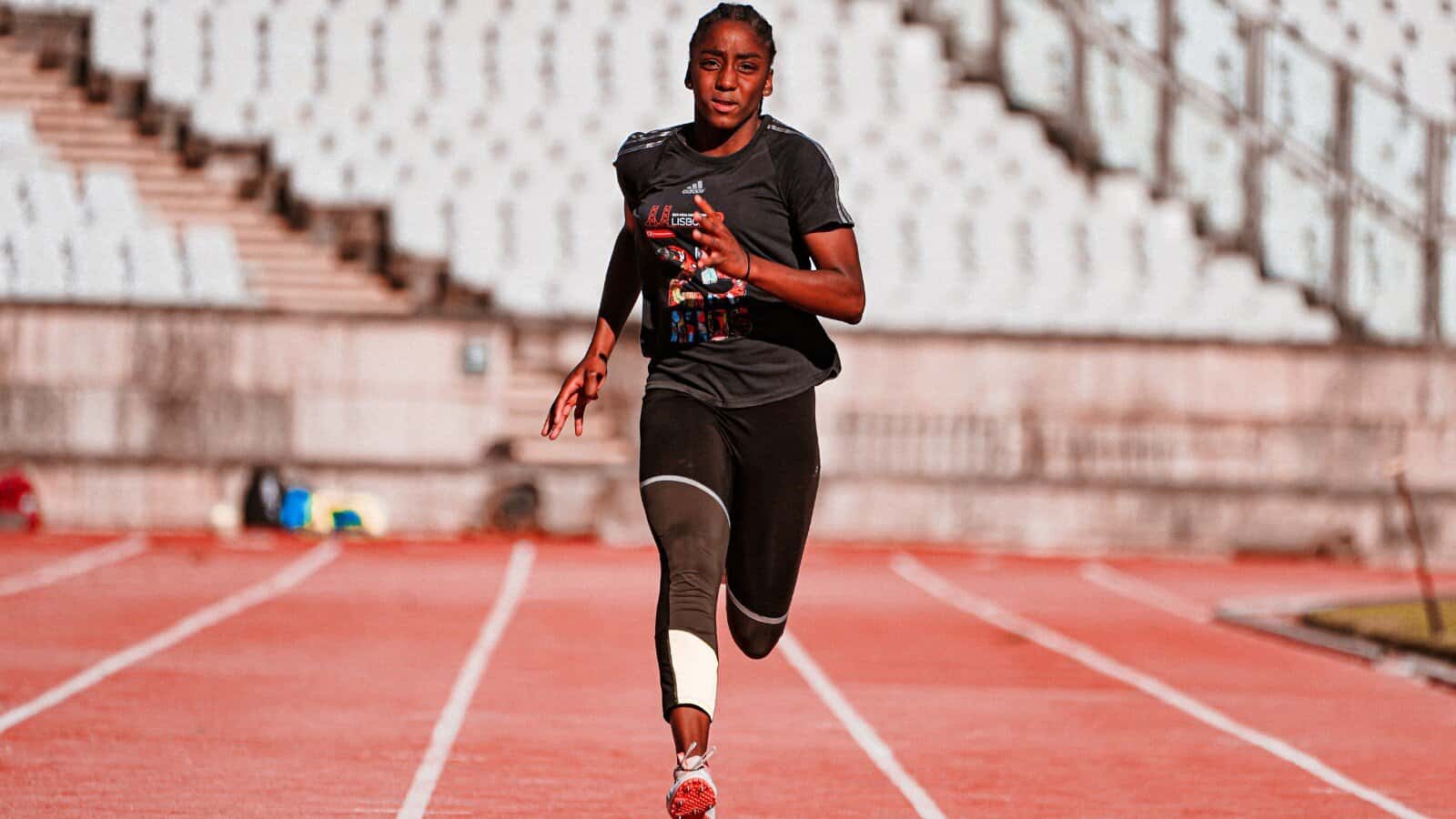Elite sprinters don’t train at maximum intensity year-round. Instead, they follow carefully structured periodisation programs that systematically develop speed, power, and technique while managing fatigue and preventing injury.
Understanding how to properly periodise sprint training is crucial for athletes and coaches seeking consistent improvement and peak performance timing.
Periodisation represents the systematic planning of athletic training that divides the training year into distinct phases, each with specific goals and training emphases.
For sprinters, this approach allows for the development of multiple performance qualities while ensuring athletes peak at the right moments for competition.
Understanding Periodisation Structure
Periodisation operates on three interconnected levels that work together to create a comprehensive training system.
The macrocycle encompasses the entire training year or season, providing the overarching framework for achieving peak performance at target competitions. Within this structure, mesocycles represent medium-term training blocks lasting several weeks to months, each focusing on specific adaptations like maximum strength development or speed-endurance capacity.
Microcycles form the smallest unit, typically representing weekly training plans that detail specific workouts, intensities, and recovery protocols.
This hierarchical structure allows coaches to balance competing training demands while ensuring systematic progression toward performance goals. Elite sprint coaches carefully sequence these cycles to maximize adaptations while preventing overtraining and injury.
Training Load Progression Throughout Annual Cycle
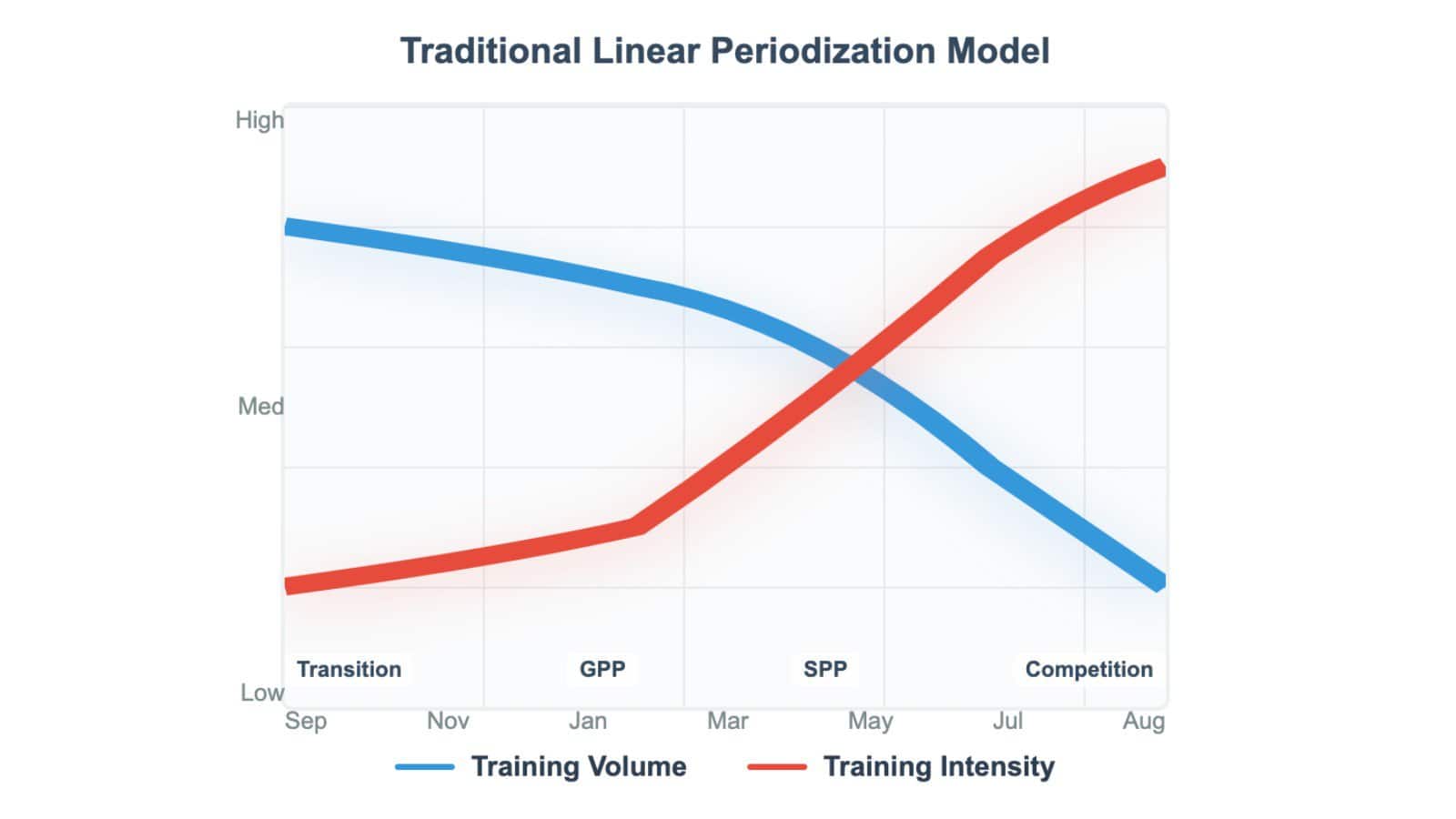
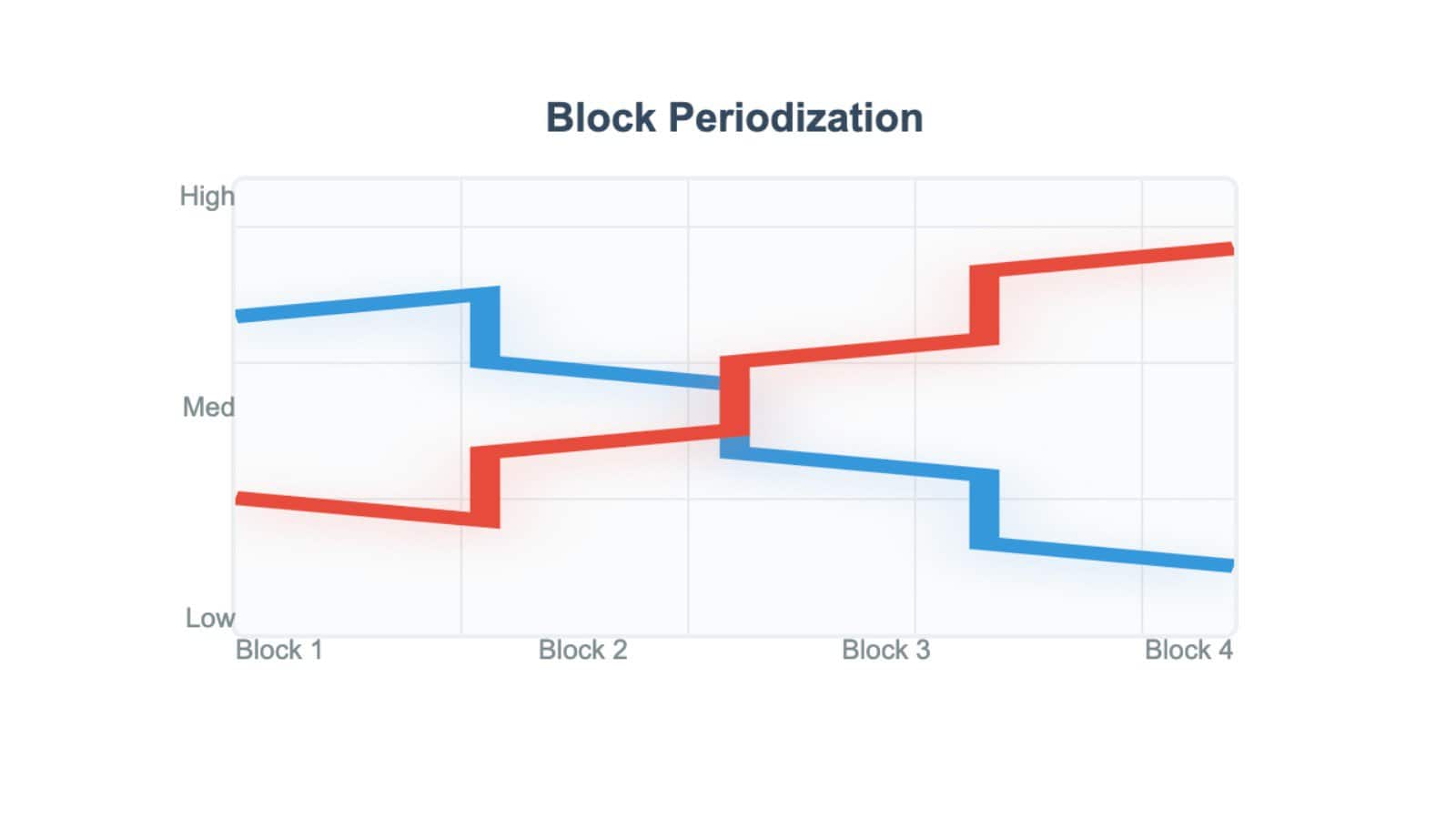
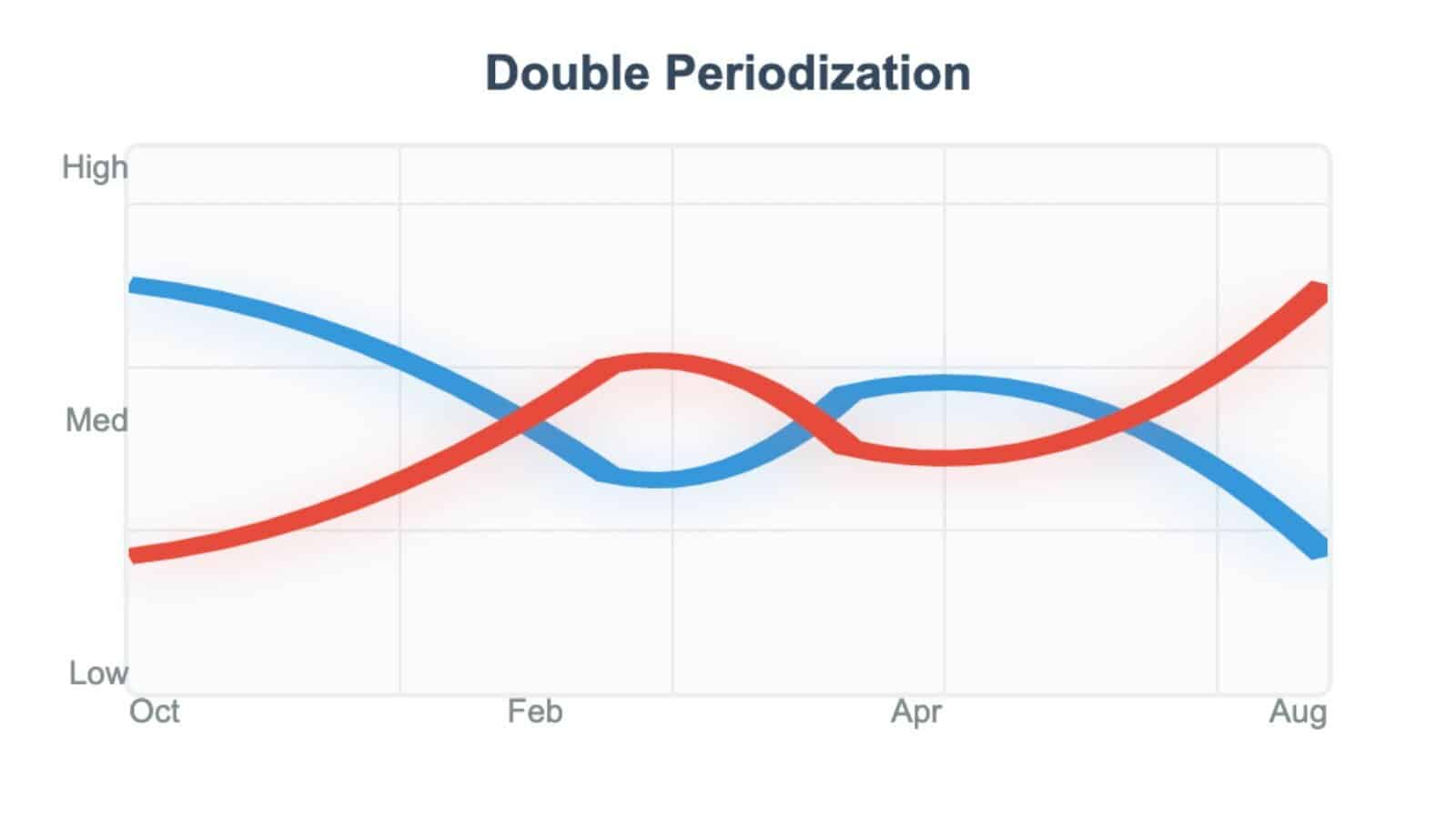
Inverse Relationship: Volume and intensity maintain an inverse relationship throughout the annual cycle. As one increases, the other decreases to prevent overtraining.
Traditional Model: Systematic progression from high volume/low intensity to low volume/high intensity. Most suitable for developing athletes.
Block Model: Concentrated training blocks focusing on specific qualities. Allows for more rapid adaptations but requires careful sequencing.
Double Periodization: Two distinct peaks allow for indoor and outdoor season optimization. Requires superior recovery capacity and training experience.
The Major Phases of Sprint Periodisation
Sprint periodisation follows a logical progression through three primary macrocycles, with the competitive phase often subdivided into multiple distinct mesocycles. Understanding the specific focus and duration of each phase allows coaches to properly sequence training stimuli and optimize performance outcomes.
Preparatory Phase: Building the Foundation (8-16 weeks)
The preparatory phase establishes the physical and technical foundation for later high-intensity work, typically lasting 8-16 weeks depending on the athlete’s competitive calendar and training history. This phase is further divided into two distinct mesocycles that systematically build capacity.
General Preparation Phase (GPP) – 8-12 weeks
The General Preparation Phase focuses on developing broad-based fitness qualities that support later sprint-specific training. Athletes emphasize building aerobic capacity, establishing movement quality, developing general strength, and creating tissue tolerance for future high-intensity work.
Training volume remains high while intensity stays moderate, allowing athletes to accumulate significant training loads without excessive neuromuscular fatigue.
Strength training during GPP emphasizes hypertrophy and general strength development through compound movements like squats, deadlifts, and Olympic lifting variations.
Athletes typically perform 3-4 strength sessions per week with higher repetition ranges (8-15 reps) and moderate loads (60-80% 1RM). This approach builds muscle mass and strengthens connective tissues while establishing proper movement patterns.
Sprint work during GPP includes extensive tempo runs at 70-75% intensity, general acceleration drills, and technique-focused speed work. Athletes may perform 2000-4000 meters of tempo running per session, developing aerobic capacity while maintaining sprint-specific movement patterns.
Technical drills emphasize basic mechanics, posture development, and movement quality rather than maximum velocity.
Specific Preparation Phase (SPP) – 6-8 weeks
The Specific Preparation Phase transitions athletes toward sprint-specific training while maintaining the fitness base established during GPP. Training intensity increases moderately while volume begins to decrease, allowing for greater focus on power development and technical refinement.
Strength training shifts toward power development through reduced repetitions (3-6 reps) and increased loads (80-90% 1RM). Olympic lifting becomes more prominent, emphasizing explosive power development and rate of force development. Athletes may reduce training frequency to 2-3 sessions per week while maintaining intensity.
Sprint work becomes more specific during SPP, incorporating longer acceleration runs (30-80 meters), speed-endurance intervals, and race-pace efforts.
Technical development focuses on sprint-specific skills like block starts, curve running, and maximum velocity mechanics. Athletes begin developing the neuromuscular coordination necessary for peak performance.
Competition Phase: Peak Performance Development (16-24 weeks)
The competition phase represents the longest and most complex period of sprint periodisation, often lasting 16-24 weeks and encompassing multiple distinct mesocycles. This phase is strategically divided into indoor and outdoor seasons, each with specific performance goals and training emphases.
Indoor Season Phase (8-12 weeks)
The indoor season serves as an extended preparation period for outdoor competition while providing valuable race experience in shorter events. Indoor tracks typically host 60-meter sprints, which emphasize acceleration and early maximum velocity development. This phase allows athletes to refine race execution while building toward outdoor season performance.
Training during the indoor season focuses heavily on acceleration development and maximum velocity attainment over shorter distances.
Athletes perform extensive block start practice, acceleration runs from 20-60 meters, and flying sprint work to develop top-end speed. The technical emphasis centers on achieving maximum velocity quickly and maintaining proper mechanics at high intensities.
Strength training maintains the power-focused approach established during SPP, with athletes performing 1-2 sessions per week using heavy loads (85-95% 1RM) and low volumes. The goal is maintaining strength gains while avoiding interference with sprint training adaptations.
Many elite athletes treat the indoor season as an extended preparation phase, using competitions to gauge fitness levels and technical development rather than pursuing absolute peak performance. This approach allows for continued development while gaining valuable race experience.
Outdoor Season Phase (12-16 weeks)
The outdoor season represents the primary competitive period for most sprinters, featuring events from 100-400 meters that require different training emphases throughout the season. This phase is typically subdivided into three distinct mesocycles that systematically develop the components of sprint performance.
Acceleration and Maximum Velocity Mesocycle (4-6 weeks)
The outdoor season begins with continued emphasis on acceleration development and maximum velocity attainment. Athletes refine block start techniques, develop acceleration mechanics through 60-80 meters, and establish their seasonal maximum velocity through flying sprint work.
This mesocycle builds upon indoor season development while transitioning to longer sprint distances.
Training sessions emphasize quality over quantity, with athletes performing 2-3 high-intensity sessions per week focused on acceleration and maximum velocity development. Rest periods between repetitions are complete (3-5 minutes) to ensure maximum quality efforts.
Speed-Endurance Mesocycle (6-8 weeks)
As the outdoor season progresses, training shifts toward speed-endurance development to prepare athletes for maintaining high velocities over full competitive distances. This mesocycle is crucial for 200-meter and 400-meter specialists but remains important for 100-meter athletes who must maintain velocity through the finish line.
Speed-endurance training involves repeated sprint efforts at 90-95% intensity with incomplete recovery, developing the ability to maintain velocity under progressive fatigue. Athletes typically perform 150-300 meter repetitions with 2-3 minutes recovery, simulating the metabolic demands of competition.
Technical focus during this mesocycle emphasizes maintaining sprint mechanics under fatigue conditions. Athletes practice relaxation techniques, rhythm maintenance, and efficient movement patterns that prevent velocity decay during competitions.
Championship Preparation and Tapering (2-4 weeks)
The final mesocycle of the outdoor season focuses on preparing for major championships through systematic tapering and peak performance preparation. Training volume decreases significantly while intensity remains maximum, allowing for complete recovery and supercompensation.
Athletes perform 1-2 high-intensity sessions per week, focusing on race-specific distances and competition simulation. Technical work emphasizes race strategy, tactical execution, and mental preparation for championship competition.
Transition Phase: Recovery and Regeneration (3-5 weeks)
The transition phase provides essential recovery time that prevents burnout and allows for long-term athletic development. This phase typically lasts 3-5 weeks depending on the length and intensity of the competitive season, with athletes significantly reducing both training volume and intensity.
The primary focus shifts to active recovery, injury prevention, and mental restoration. Athletes engage in low-intensity activities like swimming, cycling, recreational sports, and general fitness activities that maintain basic conditioning without creating training stress.
This period allows for complete physiological and psychological recovery from the demands of high-intensity training and competition.
Physical recovery during the transition phase addresses any minor injuries or imbalances that developed during the competitive season.
Athletes may work with physical therapists, massage therapists, and other healthcare professionals to resolve issues and prepare for the next training cycle. This proactive approach prevents minor problems from becoming major injuries.
Mental recovery is equally important during the transition phase. Athletes need time to process the competitive season, celebrate achievements, and mentally prepare for future challenges. This psychological restoration maintains motivation and prevents burnout that can result from year-round high-intensity training.
Periodisation Models in Sprint Training
Elite sprint coaches employ various periodisation models based on their philosophical approach, athlete needs, and competition calendars. Understanding these different models provides insight into the flexible application of periodisation principles.
Traditional Linear Periodisation
Traditional linear periodisation follows a systematic progression from high volume, low intensity training to low volume, high intensity training throughout the annual cycle. This model emphasizes gradual adaptation and was developed based on Hans Selye’s General Adaptation Syndrome principles.
The traditional model begins with extensive general preparation featuring high training volumes and moderate intensities. As the competitive season approaches, volume systematically decreases while intensity progressively increases. This approach creates a smooth transition from fitness development to performance expression.
Many successful sprint coaches continue using traditional periodisation because of its logical progression and proven effectiveness. The model’s simplicity makes it particularly suitable for developing athletes who need systematic exposure to progressive training loads.
Short-to-Long Periodisation
The short-to-long model, popularized by legendary coach Charlie Francis, begins the training year with emphasis on acceleration and short sprint work before progressing to longer distances and speed-endurance development. This approach prioritizes maximum velocity development early in the season.
Short-to-long periodisation typically begins with extensive acceleration work and maximum velocity development during the preparatory phase. As the season progresses, training distances gradually increase to develop speed-endurance and lactate tolerance for longer sprint events.
This model offers several advantages including early maximum velocity development, reduced injury risk from gradual distance progression, and systematic technical development. Many elite 100-meter specialists favor this approach because it prioritizes the maximum velocity that determines success in their event.
Long-to-Short Periodisation
Long-to-short periodisation follows the opposite progression, beginning with longer distances and speed-endurance work before transitioning to shorter, more intense efforts. This model emphasizes building a strong endurance base that supports later speed development.
The long-to-short approach begins with extensive tempo work, longer speed-endurance efforts, and aerobic development during the preparatory phase. As competition approaches, training distances decrease while intensity increases, culminating in maximum velocity and acceleration work.
This model may benefit 400-meter specialists and athletes who struggle with speed-endurance, though it requires careful management to avoid interference between endurance and speed adaptations.
Block Periodisation
Block periodisation concentrates training stresses into distinct blocks lasting 2-4 weeks, each focusing on specific adaptations. This approach allows for more concentrated training stimuli and may produce faster adaptations than traditional models.
Typical blocks include maximum strength development, power conversion, speed development, and speed-endurance phases. Each block emphasizes one primary training quality while minimizing other training stresses that might interfere with adaptation.
Block periodisation requires careful sequencing to ensure adaptations from previous blocks are maintained while developing new qualities. This model may benefit experienced athletes who can handle concentrated training loads and recover quickly between blocks.
Double Periodisation
Double periodisation creates two distinct competitive peaks within a single annual cycle, typically corresponding to indoor and outdoor seasons. This approach allows athletes to achieve high-level performance twice per year while maintaining systematic development.
The double periodisation model includes two complete preparatory-competitive-transition cycles within the annual plan. Athletes achieve a moderate peak for indoor competition, undergo a brief transition period, then build toward a higher peak for outdoor championships.
This model is particularly suitable for athletes competing seriously in both indoor and outdoor seasons, though it requires careful load management to prevent overtraining and maintain motivation throughout the extended competitive period.
Annual Periodisation Timeline Examples
Understanding typical timeframes for each phase helps coaches structure effective annual training plans. These examples represent common approaches used by elite sprint programs, though individual variations exist based on competition calendars and athlete needs.
Standard Annual Plan (Single Peak Model)
September-October: Transition Phase (6-8 weeks)
- Complete rest for 2-3 weeks
- Active recovery and cross-training for 3-4 weeks
- Address injuries and imbalances
- Mental preparation for new training cycle
November-February: Preparatory Phase (16 weeks)
- General Preparation: November-December (8 weeks)
- Specific Preparation: January-February (8 weeks)
- Systematic building of strength, power, and sprint capacity
March-August: Competition Phase (24 weeks)
- Indoor Season: March-April (8 weeks)
- Outdoor Season Development: May-June (8 weeks)
- Championship Preparation: July-August (8 weeks)
Double Periodisation Model
September: Transition Phase (4 weeks)
- Brief recovery from outdoor season
- Active rest and injury prevention
October-December: Preparatory Phase 1 (12 weeks)
- General Preparation: October-November (8 weeks)
- Specific Preparation: December (4 weeks)
- Building toward indoor season
January-March: Competition Phase 1 (12 weeks)
- Indoor season competition and development
- Moderate peak for indoor championships
April: Transition Phase 2 (4 weeks)
- Brief recovery between seasons
- Maintain fitness while recovering
May-June: Preparatory Phase 2 (8 weeks)
- Specific preparation for outdoor season
- Technical refinement and power development
July-September: Competition Phase 2 (12 weeks)
- Outdoor season with major championship focus
- Peak performance for most important competitions
Youth/Collegiate Model
August-September: Transition (6 weeks)
- Recovery from previous season
- Cross-training and general fitness
October-January: Preparatory Phase (16 weeks)
- Extended preparation due to academic calendar
- Emphasis on strength and technical development
February-May: Competition Phase (16 weeks)
- Indoor season: February-March (8 weeks)
- Outdoor season: April-May (8 weeks)
- Conference and national championship focus
June-July: Summer Training (8 weeks)
- Continued development for post-collegiate athletes
- Preparation for national/international competition
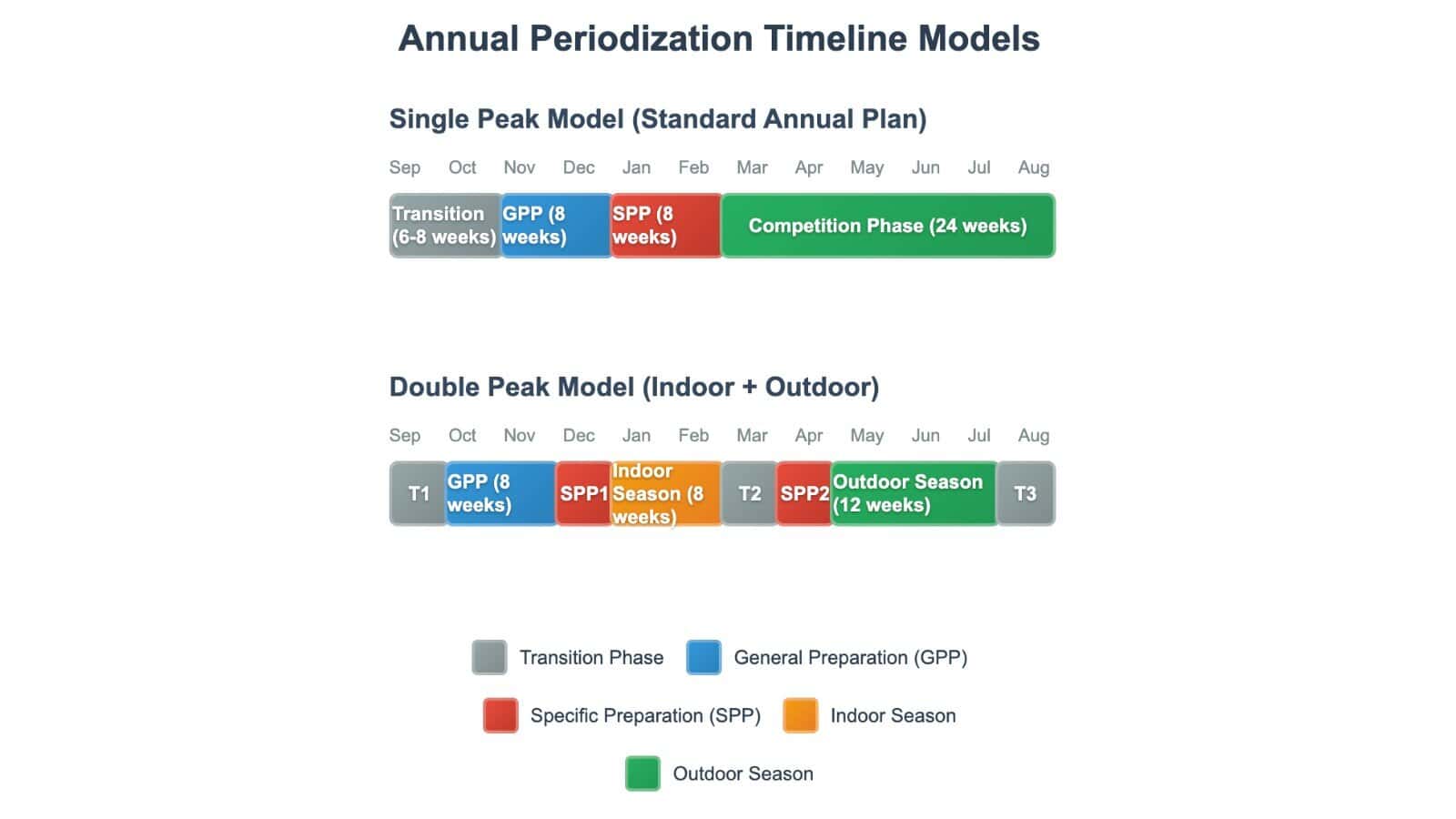
Single Peak Model: Focuses all preparation toward one major competitive peak, typically outdoor championships. Allows for longer preparation periods and deeper fitness development.
Double Peak Model: Creates two distinct competitive peaks within the annual cycle. Requires careful load management but allows for serious competition in both indoor and outdoor seasons.
Phase Durations: Times shown are typical ranges. Individual athletes may require modifications based on training age, event specialization, and competitive calendar.
Training Focus Evolution Across Phases
Strength Development Progression
Strength training follows a logical progression throughout the periodisation cycle that maximizes transfer to sprint performance.
The preparatory phase emphasizes hypertrophy and maximum strength development through high-volume, moderate-intensity training. Athletes perform compound movements with 3-5 sets of 6-12 repetitions at 70-85% of maximum effort.
As training progresses into the specific preparation phase, strength work transitions toward power development. Athletes reduce volume while increasing intensity, focusing on explosive movements and Olympic lift variations.
Training loads shift to 2-4 sets of 1-5 repetitions at 85-95% intensity, emphasizing rate of force development rather than maximum strength.
During the competition phase, strength training serves a maintenance function. Athletes perform 1-2 sessions per week using heavy loads (90-95% intensity) with minimal volume to preserve strength gains without creating fatigue.
This approach maintains the strength foundation while allowing for complete recovery between sprint sessions.
Speed Training Evolution
Sprint training maintains consistent presence throughout all phases but varies significantly in volume, intensity, and focus.
The preparatory phase includes extensive acceleration work, building speed gradually through progressive distance increases. Athletes perform multiple acceleration runs at 70-80% intensity, developing proper mechanics and neuromuscular coordination.
The specific preparation phase introduces higher intensity sprint work while maintaining technical focus. Athletes perform longer acceleration runs, speed-endurance intervals, and race-pace efforts that bridge the gap between general preparation and competition demands.
Training intensities increase to 85-95% of maximum effort with careful attention to recovery between sessions.
Competition phase sprinting emphasizes maximal velocity development and race-specific preparation. Athletes perform flying sprints, block start practice, and full-distance race simulations at maximum intensity. Training frequency decreases to 1-2 sessions per week with complete recovery between efforts.
Indoor season training focuses heavily on acceleration and maximum velocity development over shorter distances, while outdoor season training progresses through acceleration, maximum velocity, and speed-endurance emphases as outlined in the mesocycle structure.
Endurance and Tempo Work
Aerobic development plays a crucial supporting role in sprint periodisation, particularly during the preparatory phases. Tempo runs at 70-80% intensity develop aerobic capacity while maintaining sprint-specific movement patterns. These sessions typically involve 100-400 meter repetitions with short recovery periods.
During GPP, athletes may accumulate 3000-5000 meters of tempo running per week, building aerobic capacity and movement efficiency. This volume decreases during SPP as training becomes more specific, with tempo work serving primarily as recovery sessions between high-intensity efforts.
Speed-endurance training becomes prominent during the outdoor season, preparing athletes for the metabolic demands of sprint competition. Athletes perform repeated sprints at 90-95% intensity with incomplete recovery, developing lactate buffering capacity and the ability to maintain velocity under fatigue.
The indoor season minimizes speed-endurance work due to the shorter race distances, while the outdoor season systematically builds speed-endurance capacity through the dedicated mesocycle described earlier.
Training Load Management and Monitoring
Effective periodisation requires careful monitoring of training loads to prevent overtraining and optimize adaptation. Coaches track both external loads (distance, intensity, volume) and internal loads (heart rate, perceived exertion, biochemical markers) to assess athlete readiness and adjust training accordingly.
Training load periodisation follows a systematic pattern that balances stress and recovery. The preparatory phase accumulates moderate training loads over extended periods, allowing for gradual adaptation without excessive fatigue.
The competition phase introduces higher intensity loads while reducing volume, creating a more concentrated training stimulus.
Competition phase load management becomes critical for peak performance. Athletes dramatically reduce training volume while maintaining intensity, allowing for complete recovery and supercompensation. This tapering process typically reduces training loads by 50-80% in the final weeks before major competitions.
Recovery monitoring helps coaches identify optimal training loads for individual athletes. Heart rate variability, sleep quality, subjective wellness scores, and performance testing provide valuable feedback about athlete readiness and recovery status. This information guides daily training decisions and prevents overreaching.
Modern technology enables sophisticated load monitoring through GPS tracking, force plate analysis, and wearable devices. Elite programs increasingly use this data to individualize training loads and optimize performance outcomes.
Practical Implementation Guidelines
Weekly Training Structure Examples
General Preparation Phase Weekly Structure:
- Monday: Maximum strength training + acceleration work (30-60m)
- Tuesday: Extensive tempo runs (2000-3000m total) + technique drills
- Wednesday: Hypertrophy training + general plyometrics
- Thursday: Speed-endurance work (200-400m repeats at 80-85%)
- Friday: Maximum strength training + short acceleration runs
- Saturday: Long tempo runs (3000-4000m) or aerobic cross-training
- Sunday: Complete rest or light recovery activities
Indoor Season Weekly Structure:
- Monday: Power training + acceleration work (20-60m)
- Tuesday: Tempo runs (1500-2000m total) + block start practice
- Wednesday: Strength maintenance + plyometrics
- Thursday: Maximum velocity work (flying sprints, buildups)
- Friday: Light activation work + technique refinement
- Saturday: Competition or time trial (60m focus)
- Sunday: Recovery activities or complete rest
Outdoor Season Weekly Structure (Speed-Endurance Phase):
- Monday: Strength maintenance + race-pace sprints
- Tuesday: Speed-endurance work (150-300m repeats at 90-95%)
- Wednesday: Complete rest or massage/therapy
- Thursday: Maximum velocity maintenance + block starts
- Friday: Light activation work + competition preparation
- Saturday: Competition or race simulation
- Sunday: Recovery activities or complete rest
Progression Strategies
Successful periodisation requires systematic progression that challenges athletes while preventing overreaching. Volume progression typically increases by 10-20% per week during the preparatory phase, with periodic reduction weeks that allow for adaptation and recovery.
Intensity progression follows a step-like pattern, with significant increases between phases rather than gradual weekly increases. This approach allows athletes to fully adapt to training loads before introducing new stimuli.
Technical progression emphasizes movement quality over quantity, with complex skills introduced only after foundational patterns are established. Athletes master basic sprint mechanics before progressing to advanced techniques like block starts or curve running.
Load progression must account for individual differences in training age, recovery capacity, and competitive level. Younger athletes require more conservative progressions, while experienced athletes can handle larger training loads and faster progression rates.
Common Implementation Errors
Many coaches make the mistake of maintaining high intensity throughout the entire training year, leading to stagnation and increased injury risk. Proper periodisation requires patience during the preparatory phase, allowing time for foundational adaptations to occur.
Another common error involves insufficient recovery between training phases. Athletes need complete recovery to adapt to training stimuli and prepare for subsequent phases. Rushing through periodisation phases typically results in suboptimal performance and increased injury risk.
Inadequate individualization represents another significant implementation error. While periodisation principles remain consistent, individual athletes require different training loads, recovery periods, and progression rates based on their training history, age, and competitive level.
Coaches sometimes neglect the importance of the transition phase, viewing it as lost training time rather than essential recovery. This perspective leads to year-round training that eventually results in burnout and declining performance.
Performance Adaptations and Biomechanical Changes
Periodisation creates systematic changes in sprint biomechanics that optimize performance for competition. During the preparatory phase, athletes develop the strength and mobility necessary for optimal sprint mechanics. Stride length increases as athletes develop greater hip extension range and force production capacity.
The specific preparation phase refines these mechanical improvements while developing speed-specific coordination.
Athletes achieve better stride frequency through improved neuromuscular coordination and reduced ground contact times. The integration of strength and speed training creates optimal force-velocity characteristics for sprint performance.
Competition phase adaptations focus on maximizing velocity through perfect technique and neuromuscular coordination. Athletes achieve their optimal combination of stride length and frequency, minimizing energy waste while maximizing forward propulsion. These adaptations represent the culmination of months of systematic training.
Research demonstrates that elite sprinters modify their running mechanics throughout the periodisation cycle.
Stride characteristics change in response to training emphasis, with longer strides during strength phases and higher frequencies during speed phases. Competition preparation brings these elements together for optimal performance.
The indoor season typically produces improvements in acceleration mechanics and early maximum velocity attainment, while the outdoor season develops the ability to maintain these velocities over longer distances. This progression reflects the specific demands of each competitive phase.
Benefits of Systematic Periodisation
Optimal Peak Timing
The primary benefit of periodisation lies in its ability to time peak performance for important competitions. By systematically building fitness and reducing training loads, athletes can achieve their best performances when it matters most.
This approach is particularly crucial for athletes competing in championship events or Olympic Games.
Peak timing requires careful planning that accounts for individual adaptation rates and competition schedules. Athletes typically need 2-4 weeks to peak after beginning the tapering process, though this varies based on training history and competition experience.
The indoor/outdoor season structure allows for multiple performance peaks throughout the year, with each season building toward its respective championship competitions. This approach maximizes competitive opportunities while maintaining systematic development.
Injury Prevention
Periodisation significantly reduces injury risk through systematic load management and recovery integration. By varying training stresses and including planned recovery periods, athletes avoid the repetitive stress injuries common in high-intensity training programs.
The preparatory phase builds tissue tolerance through progressive loading, preparing the body for later high-intensity work. This approach is particularly important for connective tissue adaptations, which occur more slowly than muscular adaptations.
The transition phase provides essential recovery time that allows minor injuries and imbalances to resolve before they become major problems. This proactive approach to injury prevention is crucial for long-term athletic development.
Psychological Benefits
Periodisation provides important psychological benefits that maintain motivation and prevent burnout. The systematic variation in training focus keeps athletes engaged while providing clear goals and expectations for each phase.
Competition preparation creates excitement and anticipation that enhances performance. Athletes understand that their hard work is leading toward peak performance opportunities, maintaining motivation throughout challenging training periods.
The indoor season provides early competitive opportunities that build confidence and race experience without the pressure of major championships. This psychological preparation proves valuable during high-stakes outdoor competitions.
Long-term athlete development benefits from periodisation through the systematic progression of training loads and intensities. Young athletes develop training discipline and understanding that serves them throughout their careers.
Advanced Periodisation Concepts
Residual Training Effects
Understanding residual training effects is crucial for effective periodisation. Different training qualities maintain their adaptations for varying periods after training cessation. Maximum strength adaptations can last 4-6 weeks, power adaptations 2-4 weeks, and speed-endurance adaptations only 1-2 weeks.
These varying residual effects influence periodisation planning, particularly during tapering phases and between training blocks. Coaches can reduce strength training earlier than speed work while maintaining performance gains.
Block periodisation takes advantage of residual effects by sequencing training blocks to maintain adaptations from previous phases while developing new qualities. This approach requires precise timing to optimize the interaction between different training stresses.
Individualization Strategies
Modern periodisation increasingly emphasizes individualization based on athlete characteristics, training history, and genetic factors. Some athletes respond better to high-volume training, while others thrive on high-intensity work.
Training age significantly influences periodisation needs. Novice athletes require longer preparatory phases and more conservative progression rates, while experienced athletes can handle compressed timeframes and higher training loads.
Event specialization also affects periodisation structure. 100-meter specialists may emphasize maximum velocity development, while 400-meter athletes require greater speed-endurance capacity. These differences necessitate modified training emphases throughout the annual plan.
Recovery capacity varies significantly between individuals, affecting the appropriate balance between training stress and recovery. Some athletes require additional recovery time between training sessions, while others can handle higher training frequencies.
Technology Integration
Modern periodisation benefits from advanced monitoring technologies that provide objective feedback about training adaptations and recovery status. GPS tracking systems measure external training loads with high precision, while heart rate variability monitors assess autonomic nervous system status.
Force plate analysis provides detailed information about power development and neuromuscular function throughout the training cycle. This data helps coaches optimize training loads and identify when athletes are ready for higher intensity work.
Wearable devices enable continuous monitoring of sleep quality, activity levels, and physiological markers that influence training readiness. This information helps coaches make daily training adjustments based on individual athlete status.
Video analysis technology allows for detailed examination of sprint mechanics throughout the periodisation cycle, helping coaches identify technical changes and optimize performance development.
Future Directions and Considerations
Modern periodisation continues to evolve as researchers gain deeper understanding of training adaptations and recovery processes. Genetic testing may eventually allow for truly individualized training programs based on individual response patterns to different training stresses.
Artificial intelligence and machine learning applications show promise for optimizing periodisation through pattern recognition and predictive modeling. These technologies may help coaches make more informed decisions about training loads and timing.
The integration of multiple data streams (physiological, biomechanical, psychological) into comprehensive monitoring systems represents the future of periodisation. These holistic approaches will enable more precise training optimization and performance prediction.
Environmental factors like altitude training, heat acclimatization, and circadian rhythm manipulation are increasingly integrated into periodisation planning. These additional variables add complexity but offer new opportunities for performance enhancement.
Understanding periodisation principles empowers coaches and athletes to make informed training decisions that maximize performance while maintaining health and longevity. The systematic approach to training progression provides a roadmap for consistent improvement and peak performance achievement.
The science of periodisation continues to evolve, but the fundamental principles of systematic progression, planned recovery, and peak timing remain central to effective sprint training programs. Success in sprint training requires mastery of these periodisation concepts combined with careful attention to individual athlete needs and responses.

